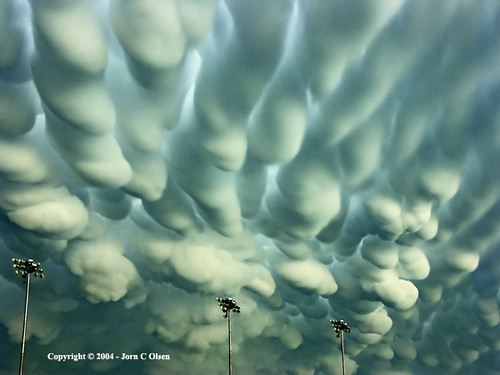Spectacular Mammatus Clouds over Hastings, Nebraska
 These photos were taken by Jorn Olsen, he lives on Heartwell Park in Hastings, Nebraska. e-mail - jolsen@dutton-lainson.com
These photos were taken by Jorn Olsen, he lives on Heartwell Park in Hastings, Nebraska. e-mail - jolsen@dutton-lainson.comHis website is: http://www.jornolsen.com/ which you may be interested in looking at. Three of these photos were featured on the front and back cover of the Journal of Meteorology and circulated in 26 countries.
From Wikipedia, the free encyclopedia.
Mammatus (also known as mamma or mammatocumulus) is a meteorological term given to a cellular pattern of pouches hanging underneath the base of a cloud. The pouches, typically measuring about half a kilometer in diameter, are often ragged, but may appear smooth. Their color is normally a bluish gray, the same as that of the host cloud, but direct illumination from the setting sun and other clouds may cause a gold or reddish cast. Mammatus may last anywhere from minutes to hours, diffusing and disappearing with time.
The mechanism of their production is not well-known and has been poorly studied. The presence of very dry air beneath the cloud base is known to be a factor.
Mammatus has often been linked with the occurrence of tornadoes, particularly during the 1950s and 1960s. Though tornadic storms often do produce mammatus under their downwind anvil, many weak storms and even stratiform clouds produce mammatus.
--

0 Comments:
Post a Comment
<< Home